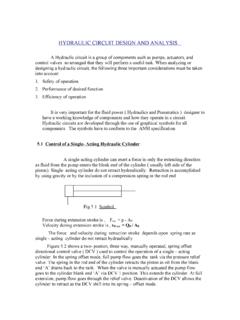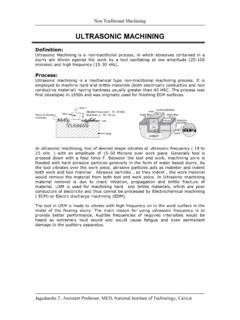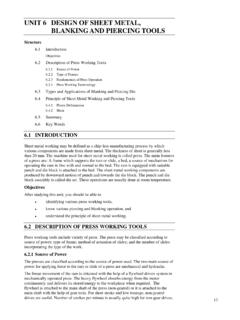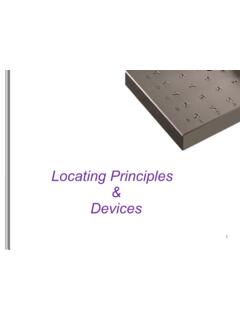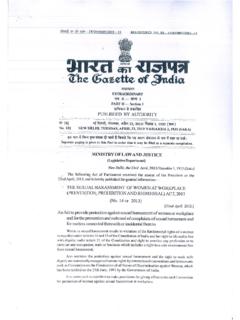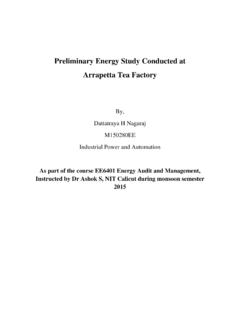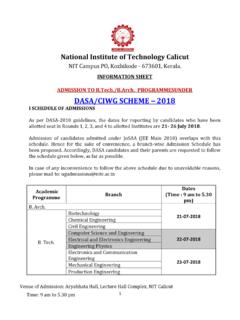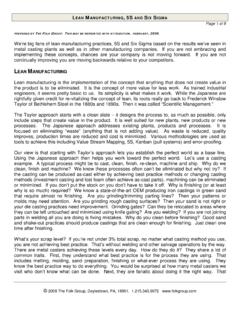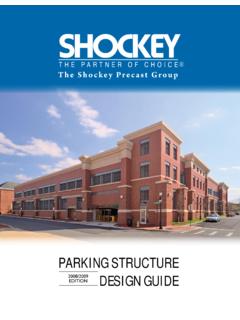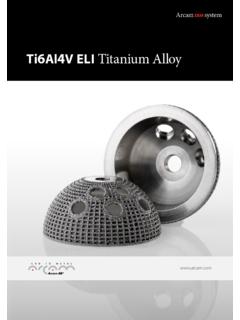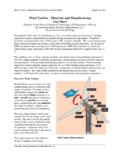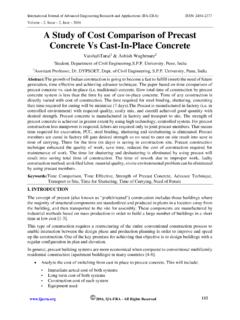Transcription of Introduction to JIGS AND FIXTURES - National Institute of ...
1 Introduction to jigs AND FIXTURES Introduction The successful running of any mass production depends upon the interchangeability to facilitate easy assembly and reduction of unit cost . Mass production methods demand a fast and easy method of positioning work for accurate operations on it. jigs and FIXTURES are production tools used to accurately manufacture duplicate and interchangeable parts. jigs and FIXTURES are specially designed so that large numbers of components can be machined or assembled identically, and to ensure interchangeability of It is a work holding device that holds, supports and locates the workpiece and guides the cutting tool for a specific operation. jigs are usually fitted with hardened steel bushings for guiding or other cutting tools. a jig is a type of tool used to control the location and/or motion of another tool.
2 A jig's primary purpose is to provide repeatability, accuracy, and interchangeability in the manufacturing of products. A device that does both functions (holding the work and guiding a tool) is called a jig. An example of a jig is when a key is duplicated, the original is used as a jig so the new key can have the same path as the old JIGFIXTURES It is a work holding device that holds, supports and locates the workpiece for a specific operation but does not guide the cutting tool. It provides only a reference surface or a device. What makes a fixture unique is that each one is built to fit a particular part or shape. The main purpose of a fixture is to locate and in some cases hold a workpiece during either a machining operation or some other industrial process. A jig differs from a fixture in that a it guides the tool to its correct position in addition to locating and supporting the workpiece.
3 Examples: Vises, chucksA VISE-JAW FIXTUREHow do jigs and FIXTURES differ jigs FIXTURES1. It is a work holding device that holds, supports and locates the workpiece and guides the cutting tool for a specific operation1. It is a work holding device that holds, supports and locates the workpiece for a specific operation but does not guide the cutting tool2. jigs are not clamped to the drill press table unless large diameters to be drilled and there is a necessity to move the jig to bring one each bush directly under the FIXTURES should be securely clamped to the table of the machine upon which the work is The jigs are special tools particularly in drilling, reaming, tapping and boring FIXTURES are specific tools used particularly in milling machine, shapers and slotting Gauge blocks are not Gauge blocks may be provided for effective Lighter in Heavier in of jigs and FixturesPRODUCTIVITY: jigs and FIXTURES increases the productivity by eliminating the individual marking, positioning and frequent checking.
4 The operation time is also reduced due to increase in speed, feed and depth of cut because of high clamping rigidity. INTERCHANGEABILITY AND QUALITY: jigs and FIXTURES facilitate the production of articles in large quantities with high degree of accuracy, uniform quality and interchangeability at a competitive cost . SKILL reduction : There is no need for skillful setting of work on tool. jigs and FIXTURES makes possible to employ unskilled or semi skilled machine operator to make savings in labour cost . cost reduction : Higher production, reduction in scrap, easy assembly and savings in labour cost results in ultimate reduction in unit cost . Fundamental principles of jigs and FIXTURES design LOCATING POINTS: Good facilities should be provided for locating the work. The article to be machined must be easily inserted and quickly taken out from the jig so that no time is wasted in placing the workpiece in position to perform operations.
5 The position of workpiece should be accurate with respect to tool guiding in the jig or setting elements in fixture. FOOL PROOF: The design of jigs and FIXTURES should be such that it would not permit the workpiece or the tool to inserted in any position other than the correct one. reduction OF IDLE TIME: Design of jigs and FIXTURES should be such that the process, loading, clamping and unloading time of the workpiece takes minimum as far as possible. WEIGHT OF jigs AND FIXTURES : It should be easy to handle, smaller in size and low cost in regard to amount of material used without sacrificing rigidity and stiffness. jigs PROVIDED WITH FEET: jigs sometimes are provided with feet so that it can be placed on the table of the machine. MATERIALS FOR jigs AND FIXTURES : Usually made of hardened materials to avoid frequent damage and to resist wear. Example- MS, Cast iron, Diesteel, CS, HSS.
6 CLAMPING DEVICE: It should be as simple as possible without sacrificing effectiveness. The strength of clamp should be such that not only to hold the workpiece firmly in place but also to take the strain of the cutting tool without springing when designing the jigs and FIXTURES . Essential features of jigs and FIXTURES reduction of idle time Should enable easy clamping and unloading such that idle time is minimum Cleanliness of machining process Design must be such that not much time is wasted in cleaning of scarfs, burrs, chips etc. Replaceable part or standardization The locating and supporting surfaces as far as possible should be replaceable, should be standardized so that their interchangeable manufacture is possible Provision for coolant Provision should be there so that the tool is cooled and the swarfs and chips are washed away Hardened surfaces All locating and supporting surfaces should be hardened materials as far as conditions permit so that they are not quickly worn out and accuracy is retained for a long time Inserts and pads Should always be riveted to those faces of the clamps which will come in contact with finished surfaces of the workpiece so that they are not spoilt Fool-proofing Pins and other devices of simple nature incorporated in such a position that they will always spoil the placement of the component or hinder the fitting of the cutting tool until the latter are in correct pos Economic soundness Equipment should be economically sound.
7 cost of design and manufacture should be in proportion to the quantity and price of producer Easy manipulation It should be as light in weight as possible and easy to handle so that workman is not subjected to fatigue, should be provided with adequate lift aids Initial location Should be ensured that workpiece is not located on more than 3 points in anyone plane test to avoid rocking, spring loading should be done Position of clamps Clamping should occur directly above the points supporting the workpiece to avoid distortion and springing Clearance Sufficient amount of clearance should be provided around the work so that operator s hands can easily enter the body for placing the workpiece and any variations of work can be accommodated Ejecting devices Proper ejecting devices should be incorporated in the body to push the workpiece out after operation Rigidity and stability It should remain perfectly rigid and stable during operation.
8 Provision should be made for proper positioning and rigidly holding the jigs and FIXTURES Safety The design should assure perfect safety of the operatorGeneral rules for designing Compare the cost of production of work with present tools with the expected cost of production, using the tool to be made and see that the cost of buildings is not in excess of expected gain. Decide upon locating points and outline clamping arrangement Make all clamping and binding devices as quick acting as possible Make the jig fool proof Make some locating points adjustable Avoid complicated clamping arrangements Round all corners Provide handles wherever these will make handling easy Provide abundant clearance Provide holes on escapes for chips Locate clamps so that they will be in best position to resist the pressure of the cutting tool when at work Place all clamps as nearly as possible opposite some bearing point of the work to avoid springing action Before using in the shop, test all jigs as soon as madeMATERIALS USED jigs and FIXTURES are made of variety of materials, some of which can be hardened to resist wear.
9 Materials generally used: High speed Steel: Cutting tools like drills, reamers and milling cutters. Die steels: Used for press tools, contain 1% carbon, to 1% tungsten and less quantities of silicon and manganese. Carbon steels: Used for standard cutting tools. Collet steels: Spring steels containing 1% carbon, manganese and less of Non shrinking tool steels: High carbon or high chromium Very little distortion during heat treatment. Used widely for fine, intricate press Nickel chrome steels: Used for High tensile steels: Used for fasteners like high tensile screws 8. Mild steel: Used in most part of jigs and FIXTURES Cheapest material Contains less than carbon 9. Cast Iron: Used for odd shapes to some machining and laborious fabrication CI usage requires a pattern for casting Contains more than 2% carbon Has self lubricating properties Can withstand vibrations and suitable for base10.
10 Nylon and Fiber: Used for soft lining for clamps to damage to workpiece due to clamping pressure 11. Phospher bronze: used for nuts as have high tensile strength Used for nuts of the lead screw Factors to be considered for design of jigs and Fixtures1. Component- Design to be studied carefully Ensure work is performed in a proper sequence Maximum operations should be performed on a machine in single setting2. Capacity of the machine- Careful consideration to be performed on type and capacity of Production requirements- Design to be made on basis of actual production requirements. Then comes decision on manual and automatic tooling Location- Location should ensure equal distribution of forces throughout all sequence of operation. Location should be hard resistant, wear resistant and high degree of accuracy.
